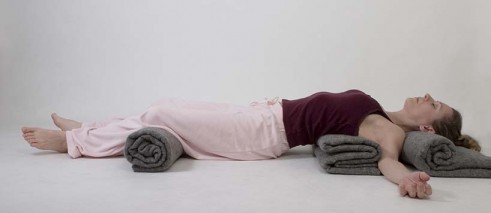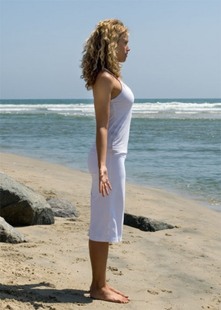|
What do yoga and Christmas have to do with each other? Nothing really….except that yoga can be a much needed refuge throughout the holidays.
What do Christmas and grief have to do with each other? Both make the other more difficult. Tomorrow is December first, and already coffee shops, and department stores are playing Christmas carols. Everyone is talking about their plans for the holidays, and social calendars are filling up with open houses, parties, and celebrations. If someone you love has died, all of this can feel bring feelings of sadness, loss and emptiness. The holidays, which once were lighthearted and enjoyable, turn challenging, and painful. What to do? There is nothing that will take away the pain and hurt of your loss, although, by approaching the holiday season with a realistic perspective of your needs, you can manage your energy levels and commitments, and create Christmas plans that support you and incorporate your loss into your experience. Talk about your grief – don’t pretend it doesn’t exist. Find caring friends and family who can listen without judgement, or express your grief in other ways like writing in a journal, writing a letter to your loved one about your feelings. It’s important to talk about the person who died – although the memories may be painful, bringing them up and incorporating them can create linking and continuing bonds. Love doesn’t end after death… Be aware, tolerant and protective of your physical and psychological limits. You may be experiening decreased energy levels, so be cautious about over-committing yourself. Take time to listen to what you need, and set boundaries that are self-supportive. It’s okay to not feel like celebrating and taking part in events you would have in the past. Plan ahead and decide which holiday traditions you would like to continue and which ones you would like to create as new – and at the same time, be conscious of your ability to modify your plans as needed. It is most important to do what is right for you. This is where yoga comes in. Your yoga practice can be the time when you quiet your mind, and connect with your body to determine the answer to the million dollar question, “what is right for me?” Yoga is a time to be quiet and to look inside yourself for the answers. It can be as simple as 5 deep breaths, or lying down and scanning your body. And, so…perhaps in the sense of Christmas and holiday “giving”we can re-visit the question, what do yoga and Christmas have to do with each other? “Yoga accepts. Yoga gives.” – April Vallei Holiday Memorials in Edmonton Grieving Parents Society Candlelight Service Sunday December 4th – 7:00 pm Knox Metropolitan United Church 8307 – 109 Street, Edmonton For further information call 780-451-5381 OR email [email protected] Parent Care Candlelight Service December 15th – 7:30pm Chapel of the Misericordia Hospital, 16940- 87 Avenue, Edmonton St. Albert Bereavement Fellowship Remembering Our Loved Ones at Christmas December 14th – 7:30pm It’s That Time Again – Going Through the Holidays When You Are Grieving Saturday December 3rd – 10:00 am Park Memorial Reception Center, 11015 – 101 Street, Edmonton
0 Comments
You can’t get very far without hearing about different styles or forms of yoga, from hot, power, core yoga to gentle and restorative yoga. I wanted to write about restorative yoga because it is such a wonderful style, yet virtually unknown. Restorative yoga doesn’t seem to have the same appeal to the marketing world as more aggressive styles of yoga that strengthen and tone the body – However, unlike the “hard” yoga styles, restorative yoga is a style that everyone can do, and everyone will benefit from. Restorative yoga promotes deep and total relaxation – a state that is rare in this day and age. The physical demands of restorative yoga are low, because all the poses are done completely supported on props (cushions, bolsters, blankets), and the physical benefits are high. When the body is properly supported and the focus is relaxing into the position, it allows the physical body to open in a way that is very gentle and soft. Further, it is through the mechanism of rest that the body can heal – on a cellular level, as well as mentally, emotionally and spiritually. Restorative yoga does just what it says it does: It restores you. It is meant to be practiced when your energy reserves are low, you are under stress or fatigued. The poses are such that you can practice them when you are unwell, or recovering from illness or major life stressors. In Yoga for Grief Support, I use restorative poses frequently. The lethargy experienced with the grief and mourning experience can be quite profound, and restorative yoga provides a way to gently approach the body and create both openness and ease. Mountain Brook Pose “I will let my body flow like water over the gentle cushions.” - Sappho Below is a restorative pose that I use to open the heart, and deepen the breath. It allows us to open parts of our body that we generally protect – our throat, heart and belly. For this pose, you will need the following props: One rolled blanket, rolled pillow or rolled yoga mat for behind your knees. Two stacked folded blankets for behind your shoulder blades. One blanket or towel rolled for behind your neck. Do not practice this pose if you have disc disease or another condition of the spine, or if you are more than 3 months pregnant. To set up for this pose:
1. Sit at the long edge of your stacked, single fold blankets. You will lay onto these blankets so they support your shoulder blades – the center line of the blankets should be just below the lower tip of your blades. This set up should not be uncomfortable in your lower back – you want to feel as though your heart is lifted, but your shoulders can relax and your lower back is long. If you feel over arched, decrease your set up by one blanket. 2. Place the rolled blanket/pillow/yoga mat behind your knees. Have enough height that the legs feel supported. 3. Place the rolled towel/blanket behind your neck so your neck and head feel support from beneath. Your neck should feel 100% relaxed. If it does not, try decreasing the height behind your shoulder blades. 4. Place your arms out to the sides at about 90 degrees or in a comfortable position in relation to your blankets. 5. Stay here for 5 minutes. Focus on relaxing your body onto the supports, as if it were water, flowing over stones in a mountain brook. Let go of tension in the muscles of the face, jaw and throat. Notice any feelings as they arise from your heart -and simply be aware of their presence. Soften and relax your belly with each exhalation. 6. When you are ready to come out, roll to one side and pause there. In time, gently press yourself to sitting. How far would you go to sustain the life of someone you love, or your own?
This is the tag line for a feature by PBS Frontline called Facing Death which looks at the complex issues around end-of-life care. I just finished watching it, and I am completely heavy-hearted for the patients and families featured in the documentary, and utterly amazed at the honesty and compassion demonstrated by the Physicicans. This documentary brings to light the advances in medical care and medical treatments, that are able to prolong life and support the functions of the body in ways that would have been considered science fiction not-so-many years ago. Along with these advances comes the difficult junction of making decisions about continuing, or discontinuing these treatments that are indeed life saving. These decisions often having to be made by people (often family members) who may or may not know the wishes of the person who’s life is at risk. It really shows the sense of responsibility on the healthcare-decision maker, being as they are often making life or death decisions, and decisions that affect their loved ones quality of life….ones that have real uncertainty as to if these decision are considered “right,” and if so, or not, by who’s standard? What I loved about the feature, is that it exemplified the fact that no one wants to die. And, no one wants a loved one to die. And, especially, no one wants to die badly. Yet, due to advances in medicine we can be put in the position where we have to weigh the risk of death against the risk of treatment, and degree of suffering created in both cases…and, not just for the patient alone, but for family members and loved ones, who have to live with the decision made either way. There is a really honest look at the fear around death – you can see it in the eyes of the people in the documentary. The fear of uncertainty, the fear of giving up, the fear of losing hope. When it really comes down to “it” is there any conversation or decision that is enough? Any conversation that won’t be felt to be unfinished when you are making decision that are so uncertain in outcome, and so full of, “what ifs?” After a death, what about the surviving loved ones, who may wonder if the right choice was made? Unfortunately, there was no chronicle on the sequelae of events after decisions were made, and patients inevitably died. It would be interesting to have a follow up piece on how this decision making responsibility can impact someones experience of grief…to look at how the survivors view their role in their loved one’s life and in their death. Undoubtedly having the experience of either prolonged medical treatment to slow or reverse a disease, or the sudden invasive treatments that are often done in ICU to save and sustain a life, bleed into the survivors experience of how they remember their loved ones, last interactions, and perceived quality of life and level of suffering endured. The documentary spoke about the monetary cost of end-of-life care, and in my heart of hearts I wondered about the emotional and psychological cost incurred by the loved ones who have to continue living after decisions were made, and their loved one has died…and to that end, why is it that the outcome of death somehow seems to be viewed as the wrong decision or in some way inevitable? Facing Death can be viewed here. After the death of a loved one, there is such power and healing in simply telling your story, over and over…retelling it as much as you need or want to. When you tell the story of your loved one, it re-affirms them as part of your life – even in their death. Sharing your experience, bit by bit, makes death real, and draws people into your life to support you. Overtime, and through the lifelong journey through grief, it’s important to find compassionate ears that will continue to hear about your loved one, and how the loss has impacted your life.
In the “olden days,” it was customary to wear black during a period of grief and mourning. This custom had multiple functions. One was to function as an outward marker of the person’s loss – and so, people would approach the ‘greiver’ and inquire about who died, and offer their support. This simple interaction created an avenue to continue to talk about the loss and receive support on an ongoing basis. In this day-and-age, we have lost this custom to wear black for an extended period of time, but we haven’t lost our need to tell our story. However, in my experience, and in the experience of people who have shared their story with me, it is increasingly difficult to openly talk about death and our experiences of loss. I was listening to a podcast this week that talked about the silent support of meditation groups. The speaker was trying to portray how being present, silently and without ‘having to do anything,’ created a sense of confidence and understanding in both the hard work of mourning and grief, and the ability to ‘sit’ in the muckiness of life. When we can be together as a group – each silently and individually experiencing our own present truth (even if the truth is painful) there is a sense of perseverance and mutual support – where we hold each other up though both the commonality and universality of our own experiences. She really put words to a sense of support I have felt both in meditation groups and in yoga classes. Silent, non-doing support. Where we can connect with other people without the verbal and/or extroverted pressure. In your journey through grief, continue to express your grief and your story outside yourself. Talk, write, sing, dance it out. Recognize that this need may not necessarily diminish over time, although it may change. Ask yourself what would feel the best in your body and mind when it comes to expressing your grief. Telling your story verbally is very powerful, and so is the silent support of all the other people (known to you or not) that have experienced deep pain. “Healing means, first of all, the creation of an empty but friendly space where those who suffer can tell their story to someone who can listen with real attention. As healers we have to receive the story of our fellow human beings with a compassionate heart, a heart that does not judge or condemn but recognizes how the stranger’s story connects with our own. We have to offer safe boundaries within which the often painful past can be revealed and the search for a new life can find a start. Our most important question as healers is not, what to say or to do? But, how to develop enough inner space where the story can be received? Healing is the humble but also very demanding task of creating and offering a friendly empty space where strangers can reflect on their pain and suffering without fear, and find the confidence that makes them look for new ways right in the center of their confusion.” – Henri J.M. Nouwen, “Reaching Out”  There is ‘energy’ in our posture – a certain je ne sais quoi about how we are standing that pronounces how we are feeling. Based on my own personal and professional experience, posture has become an obvious reflection as to the state of one’s heart. I remember a time when an acupuncturist I was seeing commented on my posture. I was sitting in a chair, slightly curled over in the chest, shoulders slumped, with my head down…a combination of punched-in-the-stomach, not having the energy to sit up, and instinctually trying to assume the fetal position. At the time, she commented that she knew I was extremely sad and traumatized. I thought she was psychic. Although, now I see what she saw – my body was saying to everyone who saw it, “I am wrought with sadness.” I didn’t have to verbalize anything. Her impression was that I was protecting my heart – and she was right. If we can project our emotions outwardly by how we are standing or sitting, we also can project that ‘energy’ inwardly – either accentuating or perpetuating a state of mind or emotion. I’m definitely not saying it’s a bad thing, in fact, I believe our bodies have infinite wisdom and instincts to assist us on our grief journey, and that our bodies assume postures they need at the time, for whatever reason. What I hope to project, however, is the idea that we are in some control of how we use our bodies, which can affect our mind and emotion. Whether it’s within our control or outside our control, our posture can give us information about our present reality. When my acupuncturist associated my posture with the idea of energetically protecting my heart, it made immediate sense. I was trying to curl up into a ball to comfort and protect myself. Now, I cannot generalize my experience to the entire grieving population, but as I have come to teach yoga to students who are grieving, I do see this posture more often than not. When I do, I see it as a physical expression of an emotional state – whatever that may be. Everyone’s grief experience is unique. It’s our yoga practice where we can go inside our bodies and be curious about our own experience. And, learn how we can use our bodies to transform our experience. In yoga, we practice tadasana (mountain pose) as a classic standing posture. It is the foundation for all other standing poses. See the photo below, and notice the ‘energy’ or feeling of how the woman is standing. It’s very different than the feeling behind the other pictures depicted above. In tadasana, we practice standing with our feet firmly planted and our legs strong. We roll our shoulders back and down, and press the crown of the head up. Symbolically, we stand in our here and now. We could even take the symbolism further and ask “what does a mountain mean to me?” and, “what qualities of a mountain can I bring into my mountain pose and my life?”
It’s important to see our physical bodies as allies in our journey through grief, by noticing the messages our bodies give us, take heed, and honour what is found. This develops compassion as we become aware of what parts of our bodies, mind and soul are in need of tender care. We can use yoga to therapeutically explore our grief – noticing how the ‘energy’ of tadasana feels, and if it is different than the energy our commonly assumed body posture. Considering the idea that our posture influences our outward and inward energy, remember that we can choose to take tadasana anytime we want. Tadasana fosters finding stability, strength and confidence, and with that intention, we can use yoga, and the movement of our bodies to influence our mind and emotion. Tadasana can be practiced daily -wherever you are – simply standing with an expression of strength in the limbs, openness in the heart, softness in the breath and mind…and see how this transcends into daily life and off the mat. “The energy accumulated in practice has a lot to do with my ability to get clarity about the reality of things.” – John Friend |
AuthorSandy Ayre Categories
All
Archives
December 2022
|
Classes
|
Helpful Info
|
|




 RSS Feed
RSS Feed
